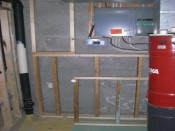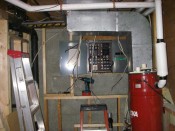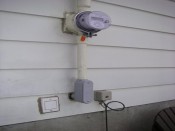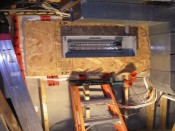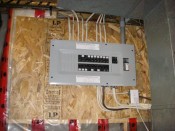Upgrading electical panel
The house was built in 1974, so there are two implications as far as electrical goes: there is aluminum wiring, and there is a fuse box.
Not too much I can do about the aluminum, and in fact, so long as it’s done properly, aluminum is quite safe. It’s still often used for service entrance wiring (eg, from the pole to your panel), and it’s still used extensively throughout the electricity distribution system. The only real problem happens when you connect devices (switches, receptacles) that aren’t rated for aluminum. There are special wire connectors to use (#63) when connecting aluminum wires, so that is something else to pay attention to.
As far as the fuse panel, there were a few reasons I wanted to replace it, even though it wasn’t absolutely essential. I wanted to insulate behind it, and it was mounted on a piece of plywood, directly on the cement wall. This meant that I’d have to completely take it off anyways to insulate, or just deal with a big uninsulated portion of the wall (seemed dumb, when I’m putting a lot of effort into insulating). I also don’t really like working with old boxes, and I do need to add a few circuits. Thought I had some space to expand, starting from scratch is easier. There is also the convenience factor, as breakers are simple easier to deal with than fuses.
I had an electrician do the upgrade, since to move the panel out from the wall, the wires coming from the meter needed to be extended a few inches. I didn’t really want to do that myself, or have to deal with Hydro One and the inspectors, so it was just simpler to pay someone else to do it.
Before the electrician showed up, I framed around the panel, and built a piece that would fit in easily.
If you look closely in the first picture below, you can see the gray conduit sticking out of the header, which goes directly to the gray pull box on the outside of the house in the next picture.
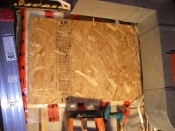 I put in the framing, and filled it with fiberglass insulation, 1 1⁄2 pieces thick, so it should be rated about R-20. A few hours after installation, I took some temperature readings: the outside temperature was ~1° Celsius; the cement wall right beside the panel was ~2° Celsius; and the plywood the panel is mounted on was ~18° Celsius.
I put in the framing, and filled it with fiberglass insulation, 1 1⁄2 pieces thick, so it should be rated about R-20. A few hours after installation, I took some temperature readings: the outside temperature was ~1° Celsius; the cement wall right beside the panel was ~2° Celsius; and the plywood the panel is mounted on was ~18° Celsius.
